- Department of Electronic System, Norwegian University of Science and Technology, Trondheim, Norway
Geophysical electromagnetic survey methods are particularly effective in locating conductive mineral deposits or mineralization zones in a mineral resource exploration. The forward modelling of the electromagnetic responses over such targets is a fundamental task in quantitatively interpreting the geophysical data into a geological model. Due to the ubiquitous irregular and complex geometries associated with the mineral rock units, it is critical that the numerical modelling approach being used is able to adequately and efficiently incorporate any necessary geometries of the Earth model. To circumvent the difficulties in representing complex but necessary geometry features in an Earth model for the existing mesh-based numerical modelling approaches (e.g., finite element and finite difference methods), I present a meshfree modelling approach that does not require a mesh to solve the Maxwell’s equations. The meshfree approach utilizes a set of unconnected points to represent any geometries in the Earth model, allowing for the maximal flexibility to account for irregular surface geometries and topography. In each meshfree subdomain, radial basis functions are used to construct meshfree function approximation in transforming the differential equations in the modelling problem into linear systems of equations. The method solves the potential function equations of the Maxwell’s equations in the modelling. The modelling accuracy using the meshfree method is examined and verified using one magnetotelluric model and two frequency-domain controlled-source models. The magnetotelluric model is the well-known Dublin Test Model 2 in which the spherical geometry of the conductor in the shallow subsurface may pose as a challenge for many numerical modelling methods. The first controlled-source model is a simple half-space model with the electric dipole source for which analytical solutions exist for the modelling responses. The second controlled-source model is the volcanic massive sulphide mineral deposit from Voisey’s Bay, Labrador, Canada in which the deposit’s surface is highly irregular. For all modellings, the calculated electromagnetic responses are found to agree with other independent numerical solutions and the analytical solutions. The advantages of the meshfree method in discretizing the Earth models with complex geometries in the forward modelling of geophysical electromagnetic data is clearly demonstrated.
1 Introduction
Geophysical electromagnetic (EM) survey methods continue to be important in the exploration of mineral resources, particularly those with a high conductivity contrast from their host rocks (e.g., copper, zinc, iron, nickle) (Strangway et al., 1973; Dyck and West, 1984; Farquharson and Craven, 2009; Smith, 2014; Gehrmann et al., 2019). In recent years, due to the increasing acknowledgement of the important role of mineral resources in energy transition, various “critical mineral resource” initiatives have been proposed (e.g., Schulz et al., 2017) and how we as a society can meet the demands has sparkled much discussion (Jones, 2023).
A geophysical EM survey directly produces a map of the distribution of electrical conductivity of the subsurface. Naturally, the interpretation of any EM data collected over a region of interest becomes vital in determining the parameters of potential mineral deposits that may host economic resources. At the centre of a quantitative interpretation of EM data is the numerical modelling of EM responses (including controlled-source EM, magnetotelluric, transient EM data) which plays a critical role in the development of theories and methods of various EM survey techniques. Of the various advancements made over the last few decades (e.g., Nabighian, 1988; Zhdanov, 2010; Smith, 2014), the numerical modelling of EM data has steadily evolved from closed-form, analytical computations of EM responses over relatively simple conductivity models that started around 1960s (Wait, 1960; Nabighian, 1988) to fully numerical simulations of Maxwell’s equations over Earth models with complex geometries and nonlinear, anisotropic conductivity distributions nowadays (e.g., Newman, 2014; Han et al., 2018).
The importance of representing realistically complex geometries of conductive mineral deposits or mineralization zones in the EM data modelling becomes obvious since mineral deposits or mineralization zones are naturally of irregular shapes of geometry, with some presenting quite extreme geometries (e.g., uranium deposits associated with thin graphite Zeng et al., 2019; Lu et al., 2021). Despite the ubiquitous existence and importance of such realistic geometries, there are still significant challenges faced by numerical modelling techniques in terms of efficiently incorporating the geometries. These challenges are precisely what this study is trying to solve and in order to do so, a new type of modelling techniques called meshfree methods is used which I will present in detail in the following sections.
Numerical methods of forward modelling EM responses over a general three-dimensional (3-D) conductivity Earth model are often focused on mesh-based modelling methods in the applied geophysics which include finite difference (e.g., Yee, 1966; Taflove and Umashankar, 1990; Mackie et al., 1993; Wang and Hohmann, 1993; Newman and Alumbaugh, 1995; Streich, 2009), finite volume (e.g., Jahandari and Farquharson, 2014; Jahandari et al., 2017), integral equation (e.g., Jones and Pascoe, 1972; Hohmann, 1975; Newman et al., 1986; Farquharson and Oldenburg, 2002; Chen et al., 2021) and finite element methods (e.g., Coggon, 1971; Pridmore et al., 1981; Badea et al., 2001; Nam et al., 2007; Puzyrev et al., 2013; Li J. et al., 2017; Rochlitz et al., 2019). They are termed mesh-based modelling methods in this study because they have the common feature of relying on a mesh-based discretization (e.g., rectilinear, triangular and tetrahedral meshes; see Figure 1A,B) of the conductivity model. Among these mesh-based methods, finite difference approaches may face more challenges than others in accurately representing complex topography surfaces and irregular surface geometries of a conductor since they require tensor-grid function approximation of differential equations. In contrast, finite volume, integral equation and finite element methods do not face such limitation. It may be argued that finite element modelling techniques, if combined with unstructured meshes whose automatic generations are facilitated by modern mesh generation software (Fabri et al., 2000; Si, 2015), are the most flexible mesh-based approaches in the modelling of EM data over complex Earth models (Coggon, 1971; Günther et al., 2006; Nam et al., 2007; Miensopust et al., 2013).

Figure 1. Schematic illustration of model discretizations for 2-D irregular geometries using (A) rectilinear mesh with local quadtree refinements, (B) unstructured triangular mesh and (C) meshfree points. Adapted from Long and Farquharson (2019c).
For real-life geometries of exploration targets, unstructured meshes (e.g., triangular and tetrahedral meshes) possess a unique advantage in efficiently and accurately representing complex geometries that are important characteristics of potential exploration targets (Lelièvre et al., 2012; Lu et al., 2021). However, accurate numerical solution of EM responses using mesh-based modelling techniques, including finite element and finite volume methods, also require a certain degree of regularity of the mesh cells. In the finite element case, for example, the effect of the mesh quality (e.g., the ratio of the largest to smallest cell sizes, elongation, dihedral angles and radius-edge ratio of cells for tetrahedral meshes) on the computational accuracy is demonstrated to be significant (Du et al., 2009). Poor mesh quality can lead to very slow convergence or divergence in iteratively solving the resulting linear system of equations in modelling controlled-source EM data using a vector finite element implementation (Ansari and Farquharson, 2014). On the other hand, ensuring the quality of the mesh can lead to overwhelmingly excessive number of elements in the generated mesh, therefore intractable computational resources, in order to sufficiently conform to the real geometries in the model (Schwarzbach et al., 2011; Nalepa et al., 2016).
The dilemma in balancing the quality of unstructured meshes and the number of mesh cells is often addressed using adaptive mesh refinement techniques (Oden and Prudhomme, 2001; Key and Ovall, 2011; Schwarzbach et al., 2011; Ren et al., 2013; Zhang et al., 2018; Spitzer, 2024). In an adaptive mesh refinement approach, the current mesh used for the modelling of EM responses can be further refined or coarsened based on an estimate of the current numerical modelling error. The ideal result is that only the part of the mesh with the largest numerical errors is refined. In the unstructured mesh scenario, the adaptive refining process is often carried out by locally modifying the mesh, rather than re-meshing the whole Earth model, due to the concern of efficiency and robustness of the process (Zhang et al., 2018; Liu et al., 2023). However, complications may arise during the adaptive mesh refining. First, as the topology of the mesh changes at each refining step the mapping between the old mesh and the new mesh needs to be calculated in order to update the degrees of freedom, which can be an expensive and rather complicated process. Second, further dividing the cells in the current mesh may produce “hanging nodes” due to the non-conforming new cells within the parent cells (Jahandari et al., 2021). The nonconformity of the new mesh may be eliminated at the cost of further refining neighbouring cells, often with a lower quality of the generated new cells.
Alternatively, the Earth model can be discretized using meshfree points (see Figure 1C) and the corresponding numerical modelling techniques are called meshfree methods (Nguyen et al., 2008; Chen et al., 2017). A set of unconnected points, or meshfree points, serve for the same purpose as that of a quality mesh in obtaining an accurate numerical solution in forward modelling the EM data. Because of the lack of connectivity among the points, the physical property distribution (i.e., the conductivity distribution for EM data modelling) will be sampled on the points when discretizing the partial differential equations. With a meshfree point discretization, the density and regularity of the point distribution are still important for accurate numerical modellings; however, the advantages of manipulating points over mesh generations are:
• With comparable regularity of a quality mesh, the generation of points requires much less effort in computer programming and is more straightforward. Also, the development of dedicated point generation software is also significantly easier (Fornberg and Flyer, 2015).
• Since there is no topology requirement, the generation of quality, unstructured meshfree points can be more robust than generating a quality unstructured mesh (Du et al., 2002; Slak and Kosec, 2019).
• Adaptive point refining and/or coarsening is more computationally efficient than the same process when using meshes, since any addition or deletion of local points does not need to affect the rest of the points. The nonconformity issue and its complications in a mesh-based adaptive refining are completely removed (Rabczuk and Belytschko, 2005).
Based on a distribution of points, many meshfree methods for solving partial differential equations have been proposed (Chen et al., 2017). For geophysical data modelling, however, only a few different meshfree methods have been proposed for seismic wave field modelling (e.g., Jia and Hu, 2006; Takekawa et al., 2015; Li B. et al., 2017), gravity data modelling (e.g., Long and Farquharson, 2019c) and EM data modelling (e.g., Wittke and Tezkan, 2014; Long and Farquharson, 2017; Long and Farquharson, 2019a; Long and Farquharson, 2019b). In general, different meshfree methods differ in the choice of basis functions, the types of meshfree points (i.e., uniform or unstructured) and in that whether numerical integration is required in transforming the partial differential equations into the linear system of equations. The meshfree method demonstrated here, mostly known as radial-basis-function based finite difference (RBF-FD), does not need the potentially expensive step of numerical integration. It also naturally supports unstructured point distributions allowing for an efficient discretization of complex-geometry conductivity models. Meshfree modelling of EM data is considered to be more challenging than those of seismic and gravity data since the EM fields are discontinuous across conductivity discontinuities (Long and Farquharson, 2019b).
The rest of the study is organized as follows. The details of the meshfree modelling method in the context of numerically solving Maxwell’s equations will be first presented, which is followed by the demonstration of the numerical accuracy of the method using a magnetotelluric example and two controlled-source EM examples. Further discussions for the applicability for other types of geophysical data of the modelling method are also presented before I conclude the study.
2 Methods
2.1 Maxwell’s equations for meshfree modelling
The frequency-domain Maxwell’s equations for the electromagnetic field in the quasi-static limit are expressed as (Stratton, 2007)
for Faraday’s law and Ampère’s law, respectively. Here,
Eliminating
Here, the Earth materials are assumed to be non-ferromagnetic so that the magnetic permeability
A naive solving of Eq. 4 using numerical methods may lead to spurious or incorrect numerical solutions of EM responses if the discontinuous nature of
In the meshfree modelling of EM responses, the degrees of freedom of the unknown function (e.g.,
we have the Helmholtz equation for the potential functions:
which is obtained by substituting Eq. 5 into Eq. 4. Also, taking the divergence of Eq. 7 gives us the conservation of charge equation for the potential functions:
In Eq. 8, the distribution of electric charges resulting from EM sources such as grounded electric dipoles is represented by the term
Both potential functions,
for EM data modelling with a general source where
2.2 RBF-FD
The description of the RBF-FD meshfree numerical method here follows Long and Farquharson (2017, 2019a,b, 2020, 2024) and references therein. Like mesh-based numerical methods, the first step of the RBF-FD is to locally approximate an unknown function,
where
or in a compact matrix form
needs to be solved. The 3-D RBFs
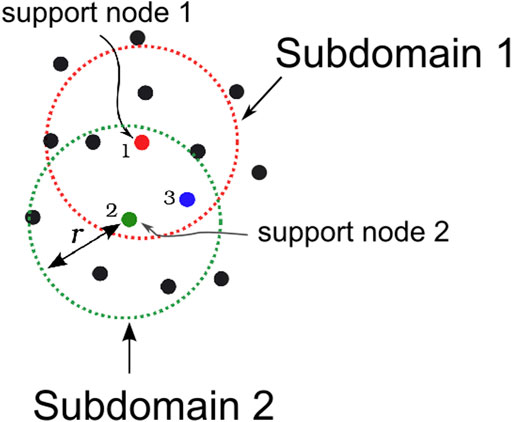
Figure 2. Illustration of meshfree subdomains. A subdomain for a point (“node”) contains a certain number of points within the chosen distance
Using the above meshfree interpolant, any differential operator
and form as the nonzeros in the corresponding rows of the coefficient matrix
3 Numerical results
In this section, the modellings of different EM data using the meshfree method are demonstrated. The global linear system from discretizing the
3.1 Magnetotelluric data
The magnetotelluric (MT) conductivity model for the demonstration of the meshfree modelling is the Dublin Test Model 2 (DTM2, Miensopust et al., 2013) in which a hemispherical conductor is buried at the top of the subsurface (Figure 3). The hemispherical conductor has the resistivity of 10
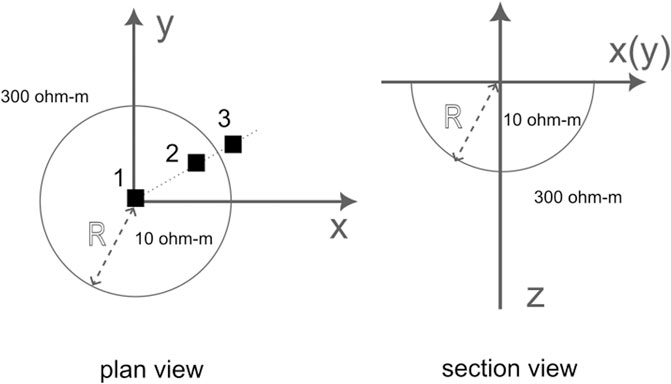
Figure 3. Schematic illustration of the Dublin Test Model 2 (DTM2). Three MT sites at the surface are marked with black squares (at
In MT data modellings, the EM source terms in Eqs 10–13, i.e.,
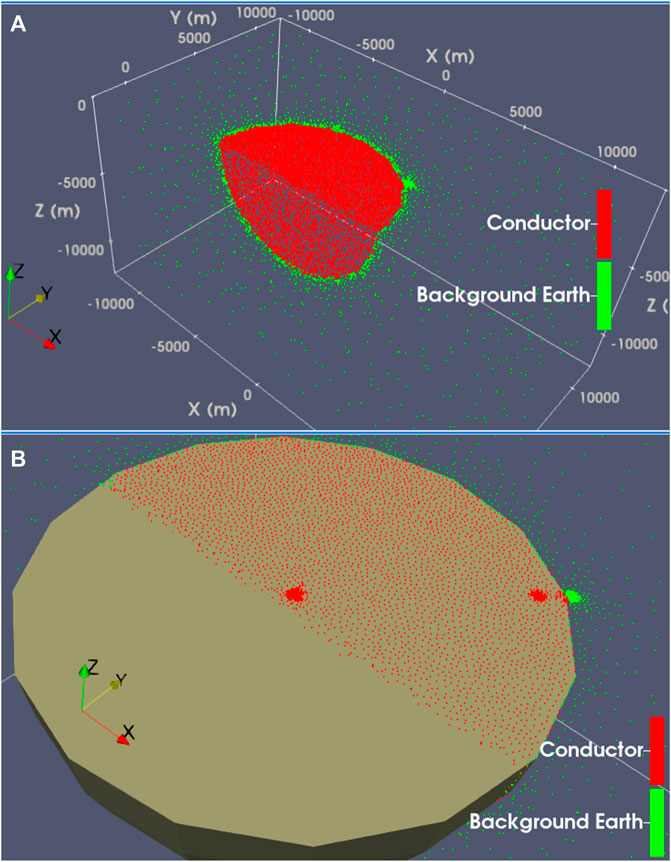
Figure 4. Perspective 3-D views of the meshfree point discretization of the Dublin Test Model 2 (DTM2). In Panel (A): unstructured points inside the conductor. In Panel (B): 3 MT sites at the surface (at
Three MT sites (Figure 3) are designed here to examine the modelling accuracy of the meshfree method. Site 1 is at the origin of the coordinate system and at the center of the hemisphere conductor. Site 2 (
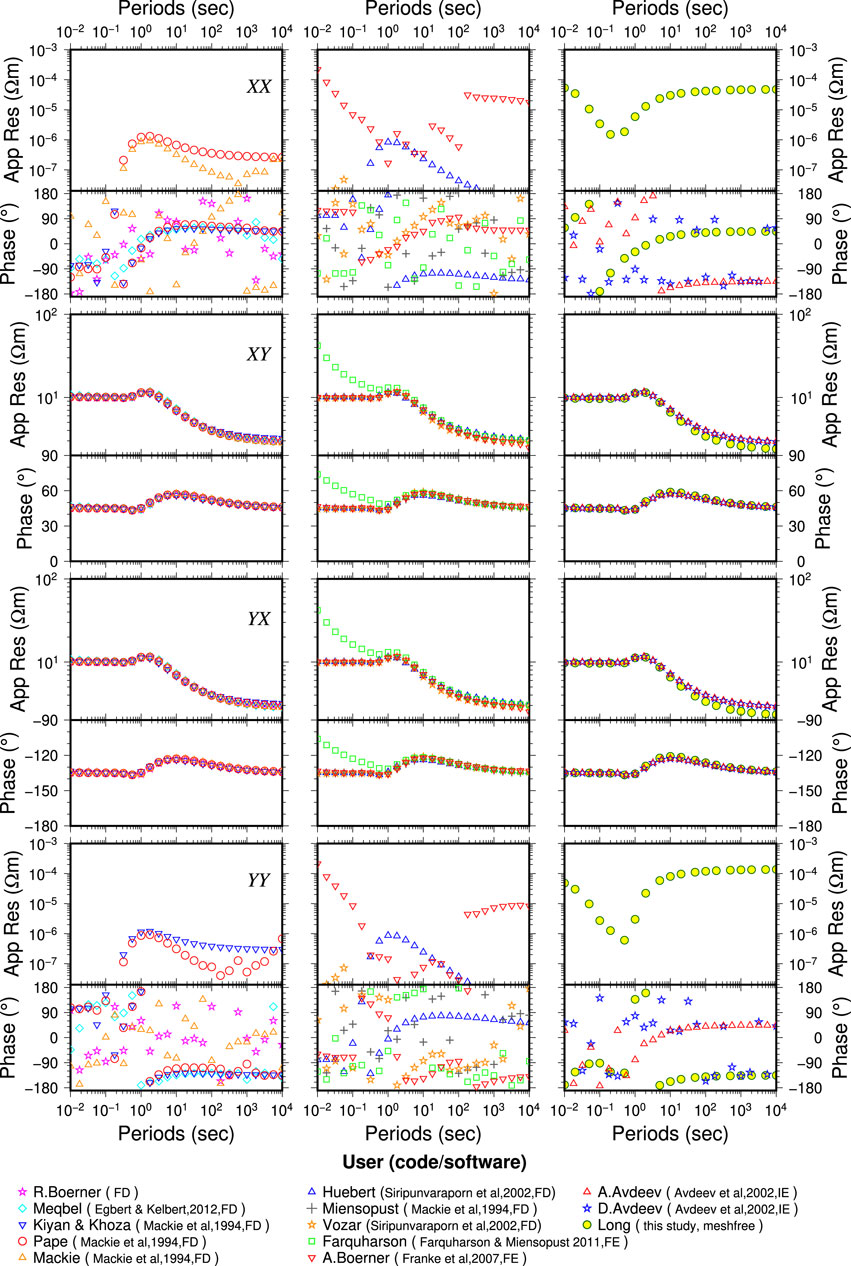
Figure 5. Comparison of the meshfree solution and other solutions for the Site-1 (origin) MT responses for DTM2. From top to bottom are XX, XY, YX, and YY components of the impedance tensor. Different users or runners of the used modelling codes are shown in the legend with algorithm acronyms as FD (finite difference), FE (finite element) and, IE (integral equation).
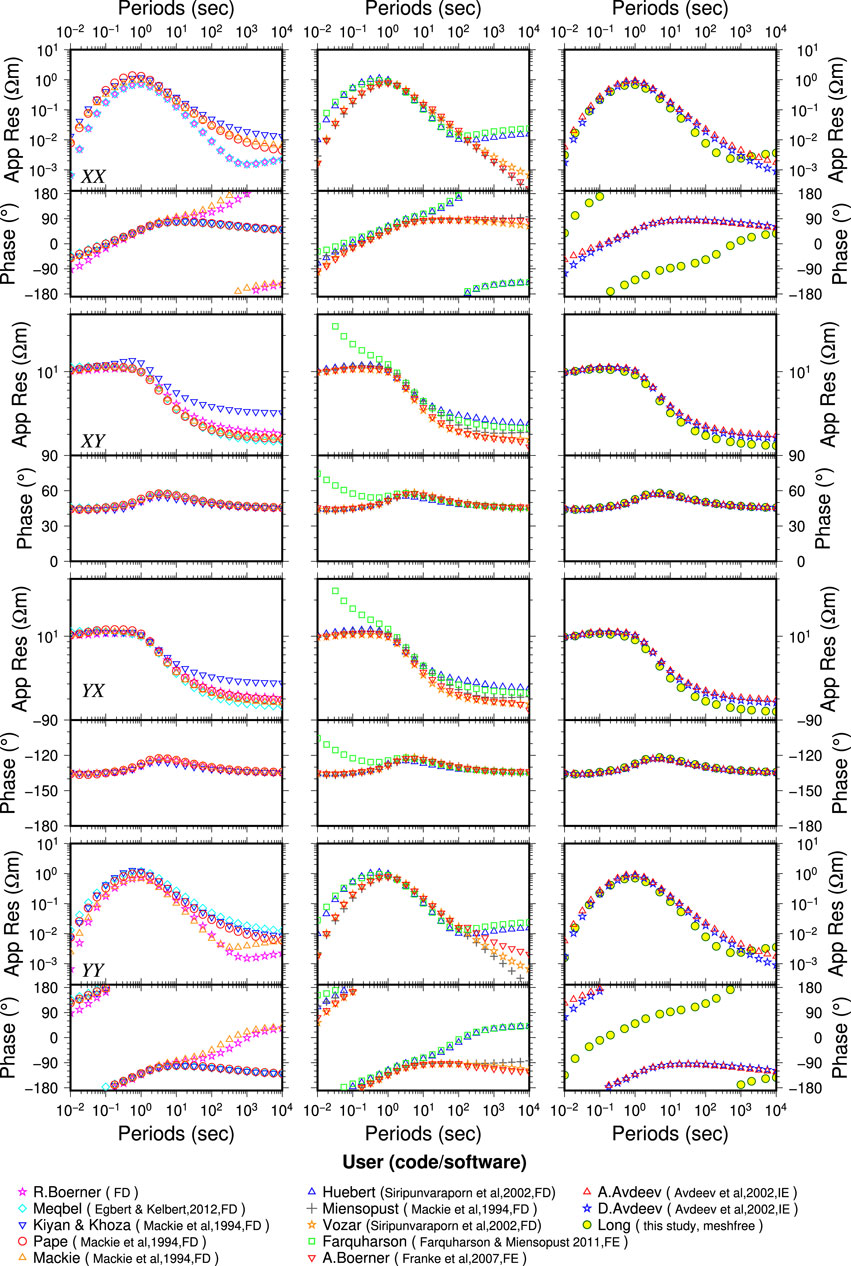
Figure 6. Comparison of the meshfree solution and other solutions for the Site-2 (
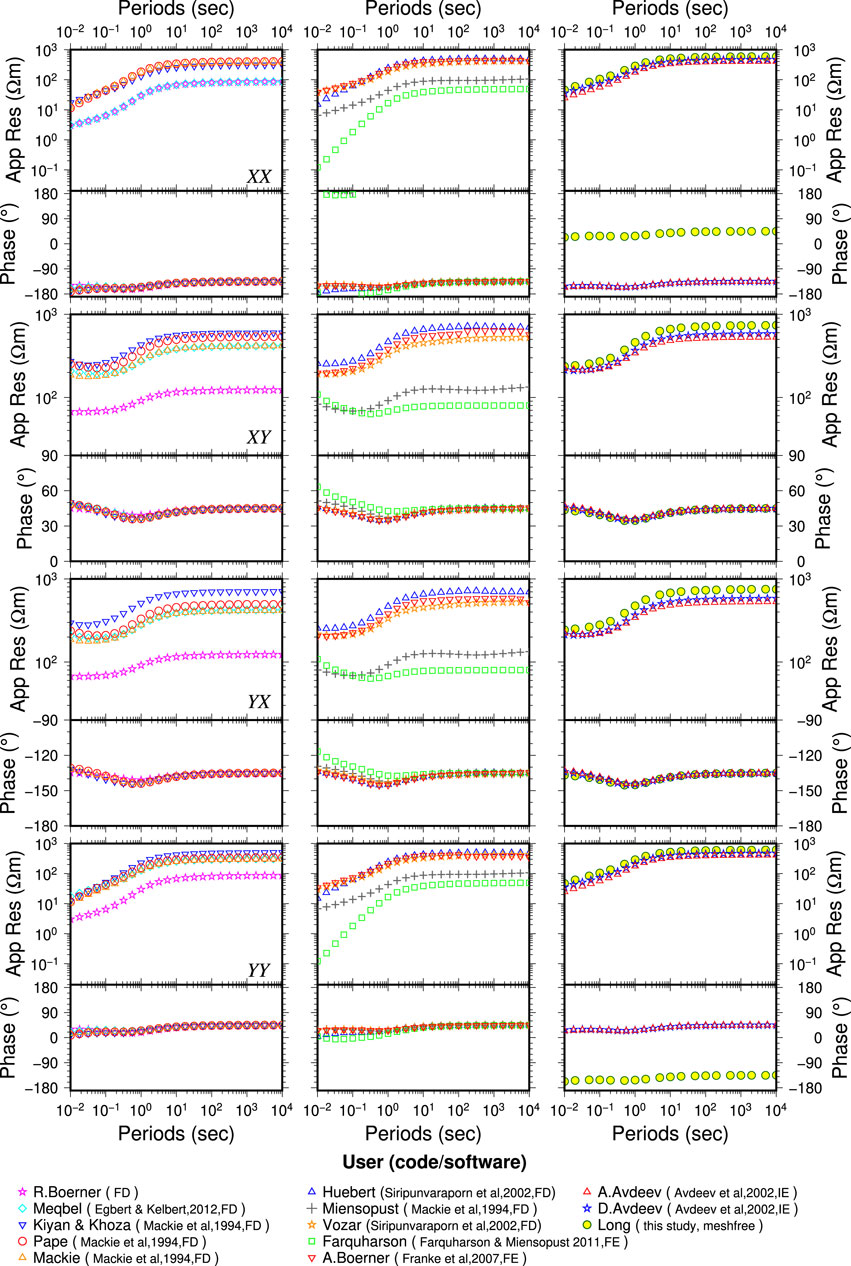
Figure 7. Comparison of the meshfree solution and other solutions for the Site-3 (
At Site 1 (Figure 5), which is at the origin of the model, the theoretical apparent resistivity of the MT responses for
3.2 Frequency-domain controlled-source EM data
To compute the controlled-source EM (CSEM) responses, the external source terms in Eqs 10–13 (
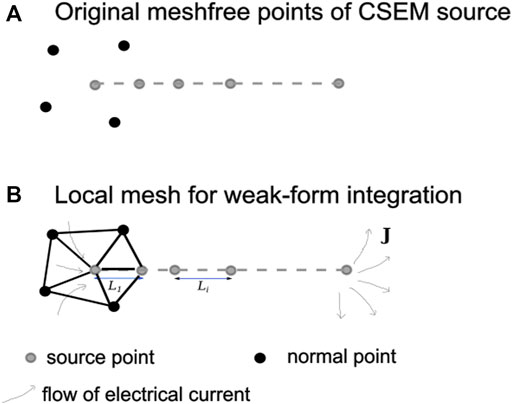
Figure 8. Schematic illustration of meshfree point representation of CSEM source wires. Panel (A): the grounded wire is represented by 5 special points designated as source points. Panel (B): for each source point, a local unstructured mesh is formed using the point (left-most source point here) and its neighbouring points.
The above method is capable of treating an arbitrarily shaped controlled source (grounded wires or current loops) in the point discretization of an Earth model. Because of this capability, the total-field approach of modelling the EM data, as described in Eqs 10–13 in the case of potential functions, is being used here and will provide more flexibility in handling complex topography and surface geometries. Under the total-field approach, the boundary values of the EM field on the computational domain is zero.
3.2.1 Half-space model
The first CSEM test model is that of a uniform subsurface with an electric dipole source at the Earth’s surface (Figure 9). Although the model is relatively ideal, analytical solutions exist for the EM fields at the surface which allows for a first-step examination of the accuracy of the developed RBF-FD meshfree method for CSEM data modellings. An
where
where
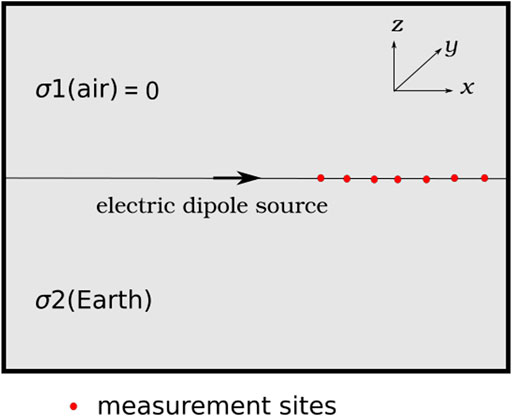
Figure 9. A half-space conductivity model with the horizontal electric dipole source (black arrow) at the top of the subsurface. Adapted from Long and Farquharson (2019a).
The current density of the electric dipole source is set to be 1 A. For the meshfree solution, a set of unstructured points with local refinements around the dipole source was used. The actual CSEM source in the meshfree modelling is 1 m in length along the
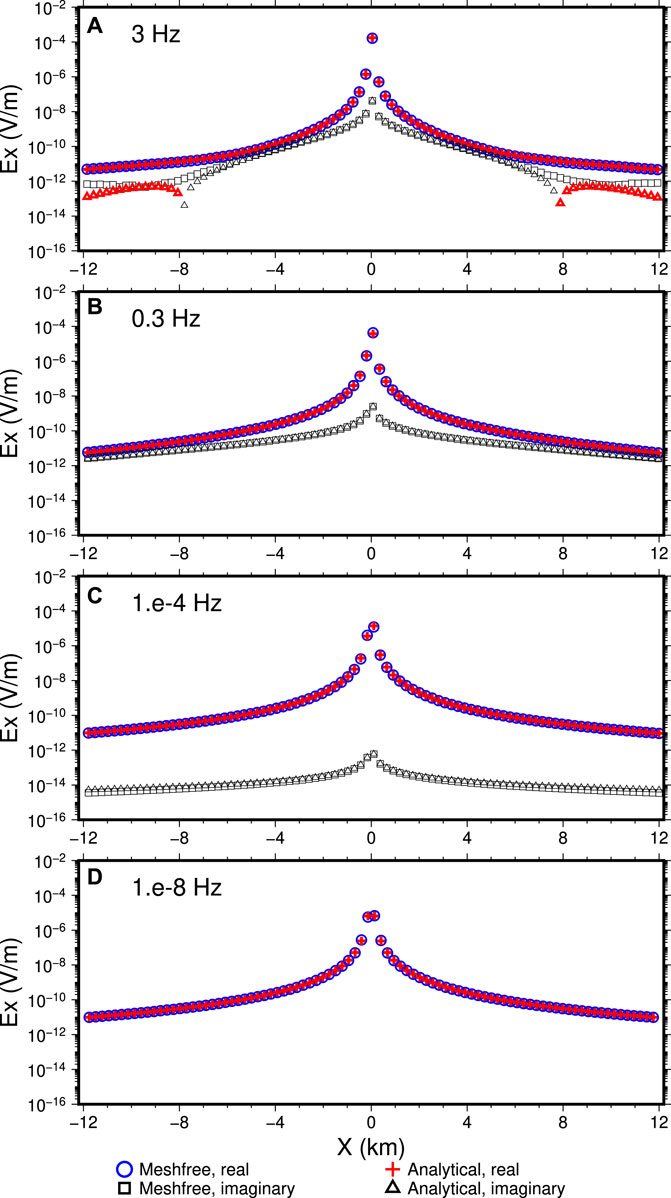
Figure 10. Comparison between the meshfree and the analytical solutions. From (A–D), each panel shows the real and imaginary parts of
3.2.2 Ovoid mineral deposit model
The second CSEM test example is from the volcanic massive sulphide mineral deposit (termed as Ovoid deposit here) from Voisey’s Bay, Labrador, Canada, which has been under extensive studies for both geology and geophysical data modelling studies (e.g., Jahandari and Farquharson, 2014; Li J. et al., 2017; Long and Farquharson, 2019c; Kara and Farquharson, 2023). The Ovoid deposit is a highly conductive iron-dominant deposit with complex surface geometry which serves as a perfect testing example for geophysical data modelling software. To test the meshfree modelling method developed here, the real topography of the Earth’s surface (also see Jahandari and Farquharson, 2014; Kara and Farquharson, 2023) has been used here. The nearest point of the deposit to the surface is about 70 m below the uneven surface (see Figure 11). Following Kara and Farquharson (2023), a grounded wire of 400 m long with a current density of 1 A along the easting direction (Figure 11A,B) is used as the source for a ground EM survey. The offset of the wire source is roughly 600 m away from the central part of the deposit. There are 143 measurement sites at the surface designed as receiver locations which are distributed evenly along 11 South-to-North profiles (Figure 11C). The profile spacing is 100 m. The site spacing along each profile is approximately 50 m. The highly conductive deposit is assumed to have a uniform conductivity of 1 S/m here and the relatively resistive background earth is assigned the conductivity of 0.001 S/m. Both conductivity values are taken from the previous test model of Kara and Farquharson (2023) for facilitating a direct comparison of the meshfree modelling results with theirs.
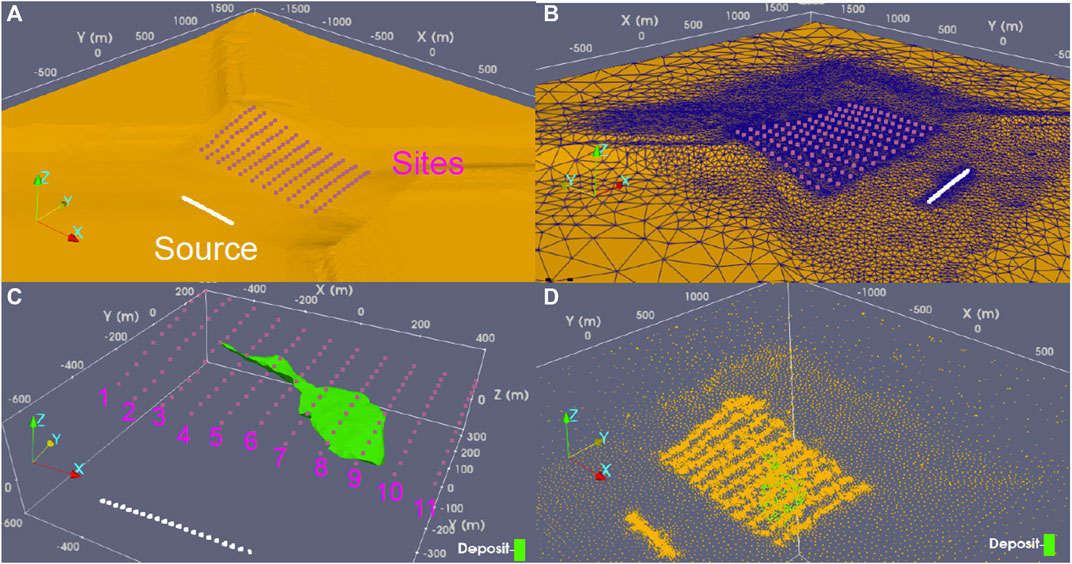
Figure 11. 3-D views of the CSEM configuration of the Ovoid deposit model. Panels (A) and (B): two different views of the grounded wire source (white dots) and the CSEM measurement sites (purple dots) overlaying the Earth’s surface with topography. Panel (C): the geometry of the Ovoid mineral deposit in the subsurface and the 11 profiles of measurement sites numbered from 1 (
For the model discretization, the meshfree points used here are also directly taken from the point distribution from the tetrahedral mesh used by Kara and Farquharson (2023) which are visualized in Figure 11D. In their modelling, they have used a vector finite element method for computing the CSEM responses. For both finite element methods and meshfree methods, the local refinements around the transmitter and the receiver locations are necessary to improve the numerical modelling accuracy. The 400-m long grounded wire is represented in the meshfree method using 80 points located at the topographic surface with in average 5 m of distance apart from each other (see Figure 8). The total number of points for this discretization is 44,230 within the computational domain of
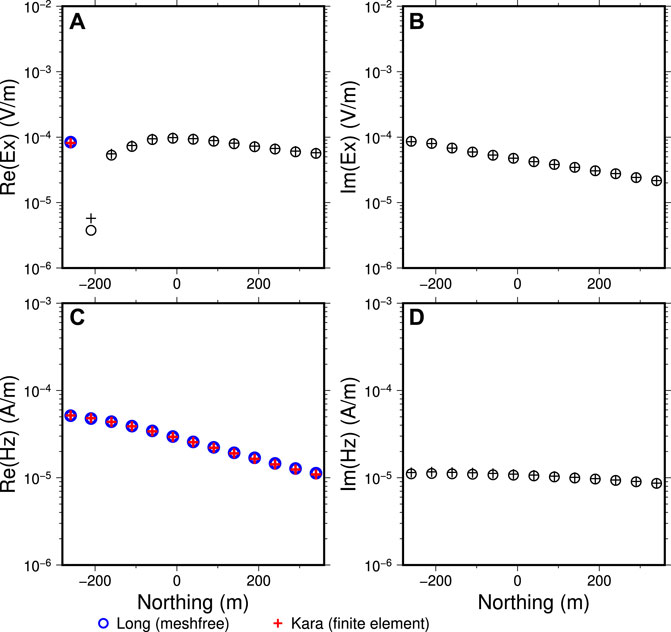
Figure 12. Computed
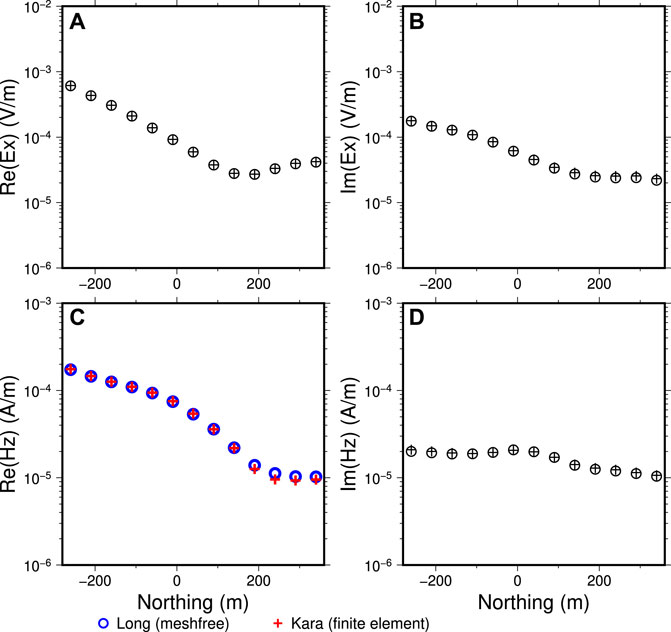
Figure 13. Computed
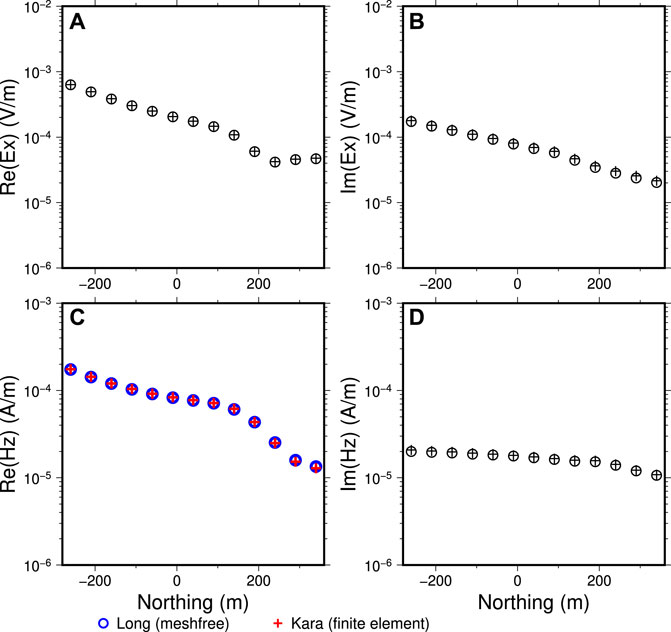
Figure 14. Computed
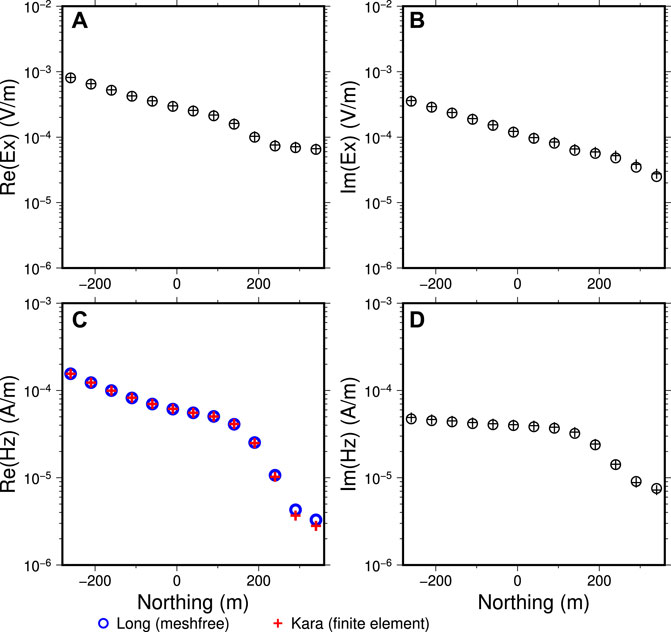
Figure 15. Same CSEM responses as in Figure 14 but at
4 Discussions
Direct current resistivity (DCR) survey methods are also frequently used for mineral resource exploration. Although I have not directly shown the modelling capability of the meshfree method for DCR data modelling, the first CSEM modelling example (in the case of
For model discretization, the unstructured meshfree points were generated using a combination of existing open-source software tools (including Tetgen and Paraview). The geophysical community is likely to continue to benefit from research in other fields. In the situation of dedicated software development for meshfree point generation, there have been significant research and development in the past decade (Fornberg and Flyer, 2015). It is anticipated that, like the history of the classical finite element methods, more open-source point generation tools will be available once the meshfree methods along with their capability of incorporating complex geometries become more widely known.
5 Conclusion
Earth models in the context of mineral resource exploration using geophysical survey methods often have rather complex surface geometries. It is important that the numerical forward modelling of geophysical EM data for such models is capable of efficiently handling these geometries. A meshfree modelling method that uses only unconnected points, instead of the traditional pixel cell-based meshes, to represent geometries has been developed and presented here. The
The modelling accuracy and the capability of handling highly irregular surface geometries of the method are demonstrated using three EM modelling examples. The first example is a magnetotelluric model in which the magnetotelluric impedance responses of a hemisphere-shaped near-surface conductor were modelled. The second example is an idealized half-space conductivity model excited with a grounded electric dipole source for which closed-form analytical solutions exist. The third example, which is also a controlled-source example, is the real-life highly conductive Ovoid mineral deposit model in which the realistic surface geometry of the deposit and the topography were used. The EM transmitter for this example is a 400 m long grounded wire. Through these examples, the feasibility of easily representing irregular surface geometries of the Earth models is clearly demonstrated. The point discretizations are considered to be more advantageous over traditional mesh discretizations for complex Earth models as they are easier to generate and manipulate. For all examples, the modelling accuracies of the meshfree method are verified using other independent numerical solutions or analytical solutions.
The demonstrated meshfree modelling method is also applicable to other geophysical data modellings in which numerical solutions and complex geometries of the model are important. The developed meshfree method for geophysical EM data modellings is shown to be effective for both natural-source magnetotelluric surveys and controlled-source EM surveys. For the magnetotelluric example, the meshing of the spherical surface geometry is a non-trivial task, especially for numerical methods that are restricted to the use of rectilinear meshes, as evident from the large differences of modelled magnetotelluric responses among some independent solutions (Miensopust et al., 2013). The representation of such geometry is however quite straightforward and easy in the meshfree point discretization.
Data availability statement
The raw data supporting the conclusions of this article will be made available by the authors, without undue reservation.
Author contributions
JL: Conceptualization, Data curation, Investigation, Methodology, Software, Writing–original draft, Writing–review and editing.
Funding
The author(s) declare that no financial support was received for the research, authorship, and/or publication of this article.
Acknowledgments
Kara and Farquharson are thanked for graciously providing the mesh data to build the Ovoid deposit model discretization and for sharing their finite element solutions to compare with in this study.
Conflict of interest
The author declares that the research was conducted in the absence of any commercial or financial relationships that could be construed as a potential conflict of interest.
Publisher’s note
All claims expressed in this article are solely those of the authors and do not necessarily represent those of their affiliated organizations, or those of the publisher, the editors and the reviewers. Any product that may be evaluated in this article, or claim that may be made by its manufacturer, is not guaranteed or endorsed by the publisher.
Footnotes
1The solutions provided from Miensopust et al. (2013) only have the computed phase angles, rather than the impedance values themselves
References
Amestoy, P., Duff, I. S., Koster, J., and L’Excellent, J.-Y. (2001). A fully asynchronous multifrontal solver using distributed dynamic scheduling. SIAM J. Matrix Analysis Appl. 23, 15–41. doi:10.1137/s0895479899358194
Ansari, S., and Farquharson, C. G. (2014). 3D finite-element forward modeling of electromagnetic data using vector and scalar potentials and unstructured grids. Geophysics 79, E149–E165. doi:10.1190/geo2013-0172.1
Badea, E. a., Everett, M. E., Newman, G. a., and Biro, O. (2001). Finite-element analysis of controlled-source electromagnetic induction using Coulomb-gauged potentials. Geophysics 66, 786–799. doi:10.1190/1.1444968
Buhmann, M. D. (2003). Radial basis functions. Cambridge: Cambridge University Press. doi:10.1017/CBO9780511543241
Chen, C., Kruglyakov, M., and Kuvshinov, A. (2021). Advanced three-dimensional electromagnetic modelling using a nested integral equation approach. Geophys. J. Int. 226, 114–130. doi:10.1093/gji/ggab072
Chen, J.-S., Hillman, M., and Chi, S.-W. (2017). Meshfree methods: progress made after 20 years. J. Eng. Mech. 143, 04017001. doi:10.1061/(asce)em.1943-7889.0001176
Coggon, J. H. (1971). Electromagnetic and electrical modeling by the finite element method. Geophysics 36, 132–155. doi:10.1190/1.1440151
Du, Q., Gunzburger, M., and Ju, L. (2002). Meshfree, probabilistic determination of point sets and support regions for meshless computing. Comput. methods Appl. Mech. Eng. 191, 1349–1366. doi:10.1016/s0045-7825(01)00327-9
Du, Q., Wang, D., and Zhu, L. (2009). On mesh geometry and stiffness matrix conditioning for general finite element spaces. SIAM J. Numer. Analysis 47, 1421–1444. doi:10.1137/080718486
Dyck, A. V., and West, G. F. (1984). The role of simple computer models in interpretations of wide-band, drill-hole electromagnetic surveys in mineral exploration. Geophysics 49, 957–980. doi:10.1190/1.1441741
Fabri, A., Giezeman, G.-J., Kettner, L., Schirra, S., and Schönherr, S. (2000). On the design of CGAL a computational geometry algorithms library. Softw. Pract. Exp. 30, 1167–1202. doi:10.1002/1097-024x(200009)30:11<1167::aid-spe337>3.0.co;2-b
Farquharson, C. G., and Craven, J. A. (2009). Three-dimensional inversion of magnetotelluric data for mineral exploration: an example from the McArthur River uranium deposit, Saskatchewan, Canada. J. Appl. Geophys. 68, 450–458. doi:10.1016/j.jappgeo.2008.02.002
Farquharson, C. G., and Oldenburg, D. W. (2002). An integral equation solution to the geophysical electromagnetic forward-modelling problem. Methods Geochem. Geophys. (Elsevier) 35, 3–19. doi:10.1016/S0076-6895(02)80083-X
Fasshauer, G. E. (2007). Meshfree approximation methods with matlab, vol. 6 of Interdiscip. Math. Sci. World Sci. doi:10.1142/6437
Fornberg, B., and Flyer, N. (2015). Fast generation of 2-D node distributions for mesh-free PDE discretizations. Comput. Math. Appl. 69, 531–544. doi:10.1016/j.camwa.2015.01.009
Gehrmann, R., North, L. J., Graber, S., Szitkar, F., Petersen, S., Minshull, T., et al. (2019). Marine mineral exploration with controlled source electromagnetics at the TAG hydrothermal field, 26°N mid-atlantic ridge. Geophys. Res. Lett. 46, 5808–5816. doi:10.1029/2019gl082928
Günther, T., Rücker, C., and Spitzer, K. (2006). Three-dimensional modelling and inversion of DC resistivity data incorporating topography-II. Inversion. Geophys. J. Int. 166, 506–517. doi:10.1111/j.1365-246x.2006.03011.x
Han, B., Li, Y., and Li, G. (2018). 3D forward modeling of magnetotelluric fields in general anisotropic media and its numerical implementation in Julia. Geophysics 83, F29–F40. doi:10.1190/geo2017-0515.1
Hohmann, G. W. (1975). Three-dimensional induced polarization and electromagnetic modeling. Geophysics 40, 309–324. doi:10.1190/1.1440527
Jahandari, H., Ansari, S., and Farquharson, C. G. (2017). Comparison between staggered grid finite–volume and edge–based finite–element modelling of geophysical electromagnetic data on unstructured grids. J. Appl. Geophys. 138, 185–197. doi:10.1016/j.jappgeo.2017.01.016
Jahandari, H., Bihlo, A., and Donzelli, F. (2021). Forward modelling of gravity data on unstructured grids using an adaptive mimetic finite-difference method. J. Appl. Geophys. 190, 104340. doi:10.1016/j.jappgeo.2021.104340
Jahandari, H., and Farquharson, C. G. (2014). A finite-volume solution to the geophysical electromagnetic forward problem using unstructured grids. Geophysics 79, E287–E302. doi:10.1190/geo2013-0312.1
Jia, X., and Hu, T. (2006). Element-free precise integration method and its applications in seismic modelling and imaging. Geophys. J. Int. 166, 349–372. doi:10.1111/j.1365-246X.2006.03024.x
Jones, A. G. (2023). Mining for net zero: the impossible task. Lead. Edge 42, 266–276. doi:10.1190/tle42040266.1
Jones, F. W., and Pascoe, L. J. (1972). The perturbation of alternating geomagnetic fields by three-dimensional conductivity inhomogeneities. Geophys. J. Int. 27, 479–485. doi:10.1111/j.1365-246X.1972.tb06103.x
Kara, K. B., and Farquharson, C. G. (2023). 3D minimum-structure inversion of controlled-source EM data using unstructured grids. J. Appl. Geophys. 209, 104897. doi:10.1016/j.jappgeo.2022.104897
Key, K., and Ovall, J. (2011). A parallel goal-oriented adaptive finite element method for 2.5-D electromagnetic modelling. Geophys. J. Int. 186, 137–154. doi:10.1111/j.1365-246x.2011.05025.x
Lelièvre, P., Carter-McAuslan, A., Farquharson, C., and Hurich, C. (2012). Unified geophysical and geological 3D Earth models. Lead. Edge 31, 322–328. doi:10.1190/1.3694900
Li, B., Liu, Y., Sen, M. K., and Ren, Z. (2017a). Time-space-domain mesh-free finite difference based on least squares for 2D acoustic-wave modeling. Geophysics 82, T143–T157. doi:10.1190/geo2016-0464.1
Li, J., Farquharson, C. G., and Hu, X. (2017b). 3D vector finite-element electromagnetic forward modeling for large loop sources using a total-field algorithm and unstructured tetrahedral grids. Geophysics 82, E1–E16. doi:10.1190/geo2016-0004.1
Liu, Z., Ren, Z., Yao, H., Tang, J., Lu, X., and Farquharson, C. (2023). A parallel adaptive finite-element approach for 3-D realistic controlled-source electromagnetic problems using hierarchical tetrahedral grids. Geophys. J. Int. 232, 1866–1885. doi:10.1093/gji/ggac419
Long, J., and Farquharson, C. G. (2017). “Three-dimensional controlled-source EM modeling with radial basis function-generated finite differences: a meshless approach,” in SEG technical program expanded abstracts 2017 (China: Society of Exploration Geophysicists), 1209–1213.
Long, J., and Farquharson, C. G. (2019a). “Meshfree modelling of 3-D controlled-source EM data: a new method to treat the singular source terms,” in SEG technical program expanded abstracts 2019 (China: Society of Exploration Geophysicists), 1050–1054.
Long, J., and Farquharson, C. G. (2019b). On the forward modelling of three-dimensional magnetotelluric data using a radial-basis-function-based mesh-free method. Geophys. J. Int. 219, 394–416. doi:10.1093/gji/ggz306
Long, J., and Farquharson, C. G. (2019c). Three-dimensional forward modelling of gravity data using mesh-free methods with radial basis functions and unstructured nodes. Geophys. J. Int. 217, 1577–1601. doi:10.1093/gji/ggz115
Long, J., and Farquharson, C. G. (2020). “Meshfree modelling of 2D MT data with RBF-FD and unstructured points,” in SEG international exposition and annual meeting (SEG). China, SEG.
Long, J., and Farquharson, C. G. (2024). Three-dimensional controlled-source electromagnetic data modelling with a hybrid meshfree-finite element approach. Germany: preparation.
Lu, X., Farquharson, C. G., Miehé, J.-M., and Harrison, G. (2021). 3D electromagnetic modeling of graphitic faults in the Athabasca Basin using a finite-volume time-domain approach with unstructured grids. Geophysics 86, B349–B367. doi:10.1190/geo2020-0657.1
Mackie, R. L., Madden, T. R., and Wannamaker, P. E. (1993). Three-dimensional magnetotelluric modeling using difference equations—theory and comparisons to integral equation solutions. Geophysics 58, 215–226. doi:10.1190/1.1443407
Miensopust, M. P., Queralt, P., Jones, A. G., and modellers, D. M. (2013). Magnetotelluric 3-D inversion—a review of two successful workshops on forward and inversion code testing and comparison. Geophys. J. Int. 193, 1216–1238. doi:10.1093/gji/ggt066
Nabighian, M. N. (1988). Electromagnetic methods in applied geophysics: voume 1, theory. Germany: Society of Exploration Geophysicists.
Nalepa, M., Ansari, S., and Farquharson, C. (2016). “Finite-element simulation of 3D CSEM data on unstructured meshes: an example from the East Coast of Canada,” in SEG technical program expanded abstracts 2016 (Germany: Society of Exploration Geophysicists), 1048–1052.
Nam, M. J., Kim, H. J., Song, Y., Lee, T. J., Son, J.-S., and Suh, J. H. (2007). 3D magnetotelluric modelling including surface topography. Geophys. Prospect. 55, 277–287. doi:10.1111/j.1365-2478.2007.00614.x
Newman, G. A. (2014). A review of high-performance computational strategies for modeling and imaging of electromagnetic induction data. Surv. Geophys. 35, 85–100. doi:10.1007/s10712-013-9260-0
Newman, G. A., and Alumbaugh, D. L. (1995). Frequency-domain modelling of airborne electromagnetic responses using staggered finite differences. Geophys. Prospect. 43, 1021–1042. doi:10.1111/j.1365-2478.1995.tb00294.x
Newman, G. A., Hohmann, G. W., and Anderson, W. L. (1986). Transient electromagnetic response of a three-dimensional body in a layered earth. Geophysics 51, 1608–1627. doi:10.1190/1.1442212
Nguyen, V. P., Rabczuk, T., Bordas, S., and Duflot, M. (2008). Meshless methods: a review and computer implementation aspects. Math. Comput. Simul. 79, 763–813. doi:10.1016/j.matcom.2008.01.003
Oden, J. T., and Prudhomme, S. (2001). Goal-oriented error estimation and adaptivity for the finite element method. Comput. Math. Appl. 41, 735–756. doi:10.1016/s0898-1221(00)00317-5
Pridmore, D., Hohmann, G., Ward, S., and Sill, W. (1981). An investigation of finite-element modeling for electrical and electromagnetic data in three dimensions. Geophysics 46, 1009–1024. doi:10.1190/1.1441239
Puzyrev, V., Koldan, J., de la Puente, J., Houzeaux, G., Vazquez, M., and Cela, J. M. (2013). A parallel finite-element method for three-dimensional controlled-source electromagnetic forward modelling. Geophys. J. Int. 193, 678–693. doi:10.1093/gji/ggt027
Rabczuk, T., and Belytschko, T. (2005). Adaptivity for structured meshfree particle methods in 2D and 3D. Int. J. Numer. Methods Eng. 63, 1559–1582. doi:10.1002/nme.1326
Ren, Z., Kalscheuer, T., Greenhalgh, S., and Maurer, H. (2013). A goal-oriented adaptive finite-element approach for plane wave 3-D electromagnetic modelling. Geophys. J. Int. 194, 700–718. doi:10.1093/gji/ggt154
Rochlitz, R., Skibbe, N., and Günther, T. (2019). custEM: customizable finite-element simulation of complex controlled-source electromagnetic data. Geophysics 84, F17–F33. doi:10.1190/geo2018-0208.1
Schulz, K. J., DeYoung Jr, J. H., Seal II, R. R., and Bradley, D. C. (2017). Critical mineral resources of the United States—an introduction. Tech. Rep. U. S. Geol. Surv. doi:10.3133/pp1802A
Schwarzbach, C., Börner, R.-U., and Spitzer, K. (2011). Three-dimensional adaptive higher order finite element simulation for geo-electromagnetics-a marine CSEM example. Geophys. J. Int. 187, 63–74. doi:10.1111/j.1365-246X.2011.05127.x
Si, H. (2015). TetGen, a delaunay-based quality tetrahedral mesh generator. ACM Trans. Math. Softw. 41, 1–36. doi:10.1145/2629697
Slak, J., and Kosec, G. (2019). On generation of node distributions for meshless PDE discretizations. SIAM J. Sci. Comput. 41, A3202–A3229. doi:10.1137/18m1231456
Smith, R. (2014). Electromagnetic induction methods in mining geophysics from 2008 to 2012. Surv. Geophys. 35, 123–156. doi:10.1007/s10712-013-9227-1
Spitzer, K. (2024). Electromagnetic modeling using adaptive grids–Error estimation and geometry representation. Surv. Geophys. 45, 277–314. doi:10.1007/s10712-023-09794-9
Strangway, D., Swift Jr, C., and Holmer, R. (1973). The application of audio-frequency magnetotellurics (AMT) to mineral exploration. Geophysics 38, 1159–1175. doi:10.1190/1.1440402
Streich, R. (2009). 3D finite-difference frequency-domain modeling of controlled-source electromagnetic data: direct solution and optimization for high accuracy. Geophysics 74, F95–F105. doi:10.1190/1.3196241
Taflove, A., and Umashankar, K. R. (1990). The finite-difference time-domain method for numerical modeling of electromagnetic wave interactions. Electromagnetics 10, 105–126. doi:10.1080/02726349008908231
Takekawa, J., Mikada, H., and Imamura, N. (2015). A mesh-free method with arbitrary-order accuracy for acoustic wave propagation. Comput. Geosciences 78, 15–25. doi:10.1016/j.cageo.2015.02.006
Wait, J. R. (1960). Propagation of electromagnetic pulses in a homogeneous conducting earth. Appl. Sci. Res. Sect. B 8, 213–253. doi:10.1007/bf02920058
Wang, T., and Hohmann, G. W. (1993). A finite-difference, time-domain solution for three-dimensional electromagnetic modeling. Geophysics 58, 797–809. doi:10.1190/1.1443465
Ward, S. H., and Hohmann, G. W. (1988). 4. Electromagnetic theory for geophysical applications. Electromagn. Methods Appl. Geophys. 1 (4), 130–311. doi:10.1190/1.9781560802631.ch4
Wittke, J., and Tezkan, B. (2014). Meshfree magnetotelluric modelling. Geophys. J. Int. 198, 1255–1268. doi:10.1093/gji/ggu207
Yee, K. S. (1966). Numerical solution of initial boundary value problems involving Maxwell’s equations in isotropic media. IEEE Trans. Antennas Propag. 14, 302–307. doi:10.1109/TAP.1966.1138693
Zeng, S., Hu, X., Li, J., Farquharson, C. G., Wood, P. C., Lu, X., et al. (2019). Effects of full transmitting-current waveforms on transient electromagnetics: insights from modeling the Albany graphite deposit. Geophysics 84, E255–E268. doi:10.1190/geo2018-0573.1
Zhang, B., Yin, C., Ren, X., Liu, Y., and Qi, Y. (2018). Adaptive finite element for 3d time-domain airborne electromagnetic modeling based on hybrid posterior error estimation. Geophysics 83, WB71–WB79. doi:10.1190/geo2017-0544.1
Keywords: mineral exploration, electromagnetic, resistivity, magnetotelluric, controlled-source, meshfree, numerical modelling
Citation: Long J (2024) Meshfree modelling of magnetotelluric and controlled-source electromagnetic data for conductive earth models with complex geometries. Front. Earth Sci. 12:1432992. doi: 10.3389/feart.2024.1432992
Received: 15 May 2024; Accepted: 13 June 2024;
Published: 11 July 2024.
Edited by:
Nannan Zhou, Chinese Academy of Sciences (CAS), ChinaReviewed by:
Hualiang Zhao, Shandong University, ChinaJianhui Li, China University of Geosciences Wuhan, China
Copyright © 2024 Long. This is an open-access article distributed under the terms of the Creative Commons Attribution License (CC BY). The use, distribution or reproduction in other forums is permitted, provided the original author(s) and the copyright owner(s) are credited and that the original publication in this journal is cited, in accordance with accepted academic practice. No use, distribution or reproduction is permitted which does not comply with these terms.
*Correspondence: Jianbo Long, amw3MDM3QG11bi5jYQ==
†Present Address: Jianbo Long, Department of Earth Sciences, Memorial University of Newfoundland, St. John's, NL, Canada
 Jianbo Long*†
Jianbo Long*†